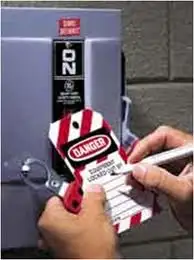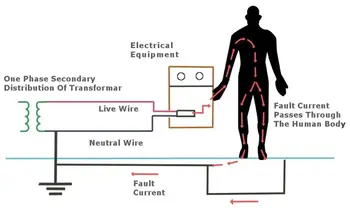OSHA Lockout Tagout
By R.W. Hurst, Editor

Arc Flash Training CSA Z462 - Electrical Safety Essentials
Our customized live online or in‑person group training can be delivered to your staff at your location.

- Live Online
- 6 hours Instructor-led
- Group Training Available
Download Our OSHA FS3529 Fact Sheet – Lockout/Tagout Safety Procedures

- Learn how to disable machines and isolate energy sources safely
- Follow OSHA guidelines for developing energy control programs
- Protect workers with proper lockout devices and annual inspections
OSHA lockout tagout (LOTO) prevents workplace injuries during equipment maintenance by controlling hazardous energy. It ensures machinery is properly shut off and not restarted before maintenance is complete. LOTO is required by OSHA for electrical safety compliance and worker protection.
What is OSHA Lockout Tagout?
OSHA Lockout Tagout (LOTO) is a safety procedure required by the Occupational Safety and Health Administration:
✅ Prevents accidental startup during maintenance by isolating hazardous energy
✅ Requires locks and tags to control machine power sources
✅ Improves workplace electrical safety and reduces injury risks
The OSHA Lockout Tagout (LOTO) regulation is designed to help companies prevent workplace injuries caused by the unexpected startup or release of hazardous energy. This article explains OSHA’s goals behind the rule, highlights the types of energy it covers, and explores why lockout tagout procedures are essential for employee safety. LOTO represents a foundational component of any effective industrial safety program, from improving compliance to reducing risk. This article provides a brief introduction to OSHA’s approach and the benefits of implementing an energy control program. A more detailed explanation of OSHA's LOTO standard can be found on our OSHA Lockout Tagout Standard page.
29 CFR 1910.147
OSHA Lockout Tagout refers to a safety standard (29 CFR 1910.147) that requires employers to isolate and control hazardous energy sources during equipment servicing to prevent unexpected startup or energy release that could cause serious worker injuries.
The Occupational Safety and Health Administration (OSHA) requires that both the authorized employee, who performs lockout/tagout procedures, and the affected employee, who operates or works near the machinery and equipment being serviced, understand their roles in hazardous energy control. OSHA mandates the control of hazardous energy by using proper energy isolating devices and lockout devices to prevent the unexpected startup of machines or equipment during maintenance. By ensuring each employee knows how to apply and respect these safety measures, organizations reduce the risk of injury and maintain full compliance with federal energy control standards.
FREE EF Electrical Training Catalog
Download our FREE Electrical Training Catalog and explore a full range of expert-led electrical training courses.

- Live online and in-person courses available
- Real-time instruction with Q&A from industry experts
- Flexible scheduling for your convenience
OSHA’s Purpose Behind the Lockout Tagout Rule
The primary objective of the LOTO standard is to prevent injuries caused by the unexpected energization or startup of machines. Before the regulation was enacted, workers routinely suffered amputations, electrocutions, burns, and crushing injuries due to uncontrolled energy sources during servicing activities.
OSHA recognized the need for a national standard that would require employers to implement:
-
Clear procedures for de-energizing and equipment servicing
-
Proper use of lockout/tagout devices
-
Employee training and role definition
-
Periodic inspections to ensure compliance
The standard applies to most general industry workplaces and covers all forms of hazardous energy: electrical, mechanical, hydraulic, pneumatic, chemical, thermal, and gravitational.
Workplace Accident Statistics
LOTO was created in response to alarming injury rates. According to data from OSHA and the U.S. Bureau of Labour Statistics:
-
Approximately 10% of serious electrical injuries are due to inadequate or missing LOTO procedures.
-
Each year, about 120 workers die from hazardous energy incidents that could have been prevented.
-
OSHA estimates that compliance with its LOTO standard prevents over 50,000 injuries and saves more than 100 lives annually.
These figures highlight the severity of the risk and the proven effectiveness of OSHA’s regulations in reducing preventable harm.
Why Lockout Tagout Matters
LOTO isn’t just a compliance checkbox—it’s a life-saving practice. Anytime an employee services or maintains machinery, there is a risk that the equipment could move unexpectedly or release stored energy. Without effective energy isolation, a routine task like clearing a jam or tightening a bolt can become fatal.
Common hazards include:
-
Machines restarting while a worker’s hands or tools are inside
-
Pneumatic lines discharging compressed air without warning
-
Hydraulic pressure suddenly moves pistons or clamps
-
Electrical circuits being re-energized mid-repair
LOTO procedures are designed to prevent these incidents by ensuring all energy sources are de-energized, locked in place, and clearly labelled before work begins.
OSHA’s Compliance Goals
The Lockout Tagout standard is built on a structured approach to safety. OSHA’s goal is to create a consistent, enforceable framework that:
-
Identifies and isolates energy sources using approved devices
-
Defines employee responsibilities (authorized, affected, and other workers)
-
Requires written procedures for equipment with more than one energy source
-
Mandates training and retraining to ensure awareness and skill retention
-
Requires periodic audits of LOTO programs and procedures
Employers are expected to document and implement a comprehensive energy control program, supported by internal procedures, training, regular inspections, and effective record-keeping.
Benefits of Following OSHA Guidelines
Adopting a robust LOTO program isn’t just about avoiding OSHA citations—it brings real business and safety value. Benefits include:
-
Fewer injuries and fatalities, leading to improved morale and trust
-
Reduced downtime from fewer accidents and smoother maintenance operations
-
Lower insurance premiums and fewer workers’ compensation claims
-
Improved equipment reliability through safer servicing practices
-
Protection from legal liability and regulatory enforcement
-
Enhanced maintenance safety culture across all departments
Investing in LOTO compliance is a direct investment in the long-term safety and efficiency of your operations.
Visit our OSHA LOTO Pages
Additional Resources:







